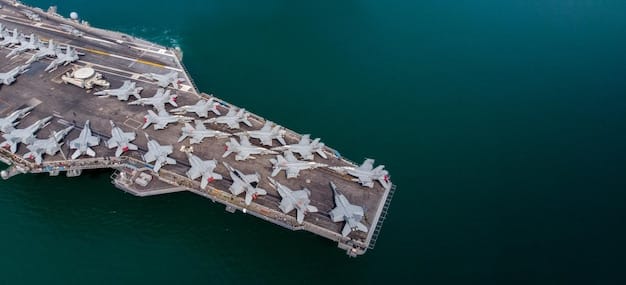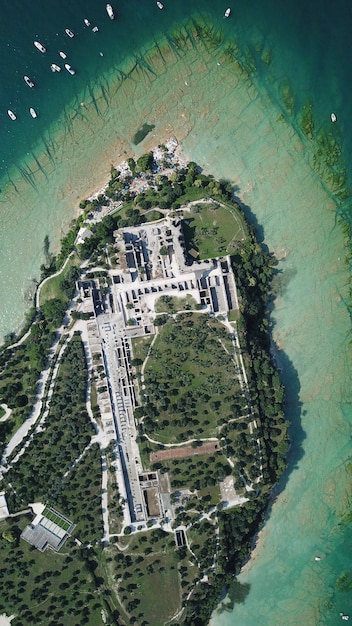US Military Drills in South China Sea: Power Play or Rising Tensions?

US military exercises in the South China Sea are a complex issue, balancing the need to project power and maintain regional stability against the risk of escalating tensions with China and other nations, raising questions about whether these drills are a necessary show of force or a provocative act.
The waters of the South China Sea have long been a site of geopolitical contestation. In recent years, the frequency and scale of US military exercises in the South China Sea: A Show of Force or Escalation of Tensions? have brought increased scrutiny.
Understanding the Geopolitical Significance of the South China Sea
The South China Sea is not simply a body of water; it represents a critical maritime pathway and a region rich in natural resources. Its geopolitical importance is multifaceted, involving territorial disputes, economic interests, and strategic military positioning.
Several nations, including China, Vietnam, the Philippines, Malaysia, and Brunei, have overlapping claims to islands and maritime zones within the South China Sea. These claims are rooted in historical narratives and interpretations of international law, particularly the United Nations Convention on the Law of the Sea (UNCLOS).
Territorial Disputes and Overlapping Claims
The core of the geopolitical conflict lies in the competing territorial claims. China asserts its rights over a vast area within the “nine-dash line,” a boundary that encompasses most of the South China Sea. This claim clashes with the Exclusive Economic Zones (EEZs) of other littoral states, leading to frequent standoffs and diplomatic tensions.
Economic Interests and Resource Control
The South China Sea holds significant economic value, serving as a major shipping route for global trade. Beyond trade, the seabed is believed to contain substantial reserves of oil and natural gas. Access to these resources is a key driver for the nations asserting their claims.
- Shipping Lanes: The South China Sea facilitates trillions of dollars’ worth of trade annually, making it a vital artery for the global economy.
- Natural Resources: The potential for oil and gas deposits attracts nations eager to secure their energy future.
- Fishing Grounds: The waters are important fishing grounds, providing sustenance for local populations and contributing to regional economies.
The strategic importance of the South China Sea is accentuated by its role as a potential flashpoint for military conflict. The United States, while remaining neutral on the territorial disputes, asserts its interest in maintaining freedom of navigation and overflight, often challenging China’s expansive claims through naval patrols and military exercises. This presence is viewed by some as a necessary counterbalance to China’s growing military power, while others see it as an unnecessary provocation.
In conclusion, the geopolitical significance of the South China Sea is a complex interplay of territorial conflicts, economic stakes, and military strategies. Understanding these dynamics is essential for assessing the impact and implications of US military exercises in the region.
The Nature and Scope of US Military Exercises
US military involvement in the South China Sea is characterized by a range of activities, from freedom of navigation operations (FONOPs) to large-scale military exercises. These exercises involve various branches of the US military and often include participation from allied nations.
The exercises serve multiple purposes, including testing military readiness, enhancing interoperability with allies, and projecting US power in the region. They are typically conducted within international waters and airspace, but their proximity to disputed territories often elicits strong reactions from China.
Freedom of Navigation Operations (FONOPs)
FONOPs are a key aspect of the US presence in the South China Sea. These operations involve US warships sailing within the 12-nautical-mile territorial waters claimed by China around some of the disputed islands. The US asserts that these operations are consistent with international law and designed to challenge excessive maritime claims.
Joint Military Exercises with Allies
The US frequently conducts joint military exercises with its allies in the region, including countries like Australia, Japan, and the Philippines. These exercises involve naval maneuvers, amphibious landings, and air defense drills.
- Enhancing Interoperability: Joint exercises improve the ability of different military forces to work together effectively.
- Demonstrating Solidarity: They send a strong signal of support to allies facing pressure from China.
- Developing Capabilities: They provide opportunities to develop advanced military capabilities in a complex operational environment.
The scale and complexity of US military exercises in the South China Sea have increased over time, reflecting the growing strategic importance of the region. These exercises typically involve multiple ships, aircraft, and thousands of personnel. The US military also uses these exercises to test new technologies and tactics, ensuring its forces remain at the cutting edge.
In conclusion, US military exercises in the South China Sea encompass a broad range of activities, from FONOPs to large-scale joint drills. These exercises are aimed at projecting power, maintaining freedom of navigation, and reassuring allies. However, they also contribute to heightened tensions and raise questions about their ultimate impact on regional stability.
China’s Perspective and Response to US Military Activities
China views US military activities in the South China Sea with deep suspicion and considers them a direct challenge to its sovereignty and security interests. Beijing argues that the US is deliberately stirring up trouble in the region and undermining its efforts to maintain stability.
China’s response to US military exercises has been multifaceted, ranging from diplomatic protests to military deployments. The Chinese government has consistently accused the US of interfering in regional affairs and violating international law. Meanwhile, the People’s Liberation Army (PLA) has stepped up its own military presence in the South China Sea, conducting drills and patrols in response to US actions.

Diplomatic Protests and Legal Arguments
China has lodged numerous diplomatic protests with the US over its military activities in the South China Sea. Beijing asserts that these activities violate the spirit of cooperation and mutual respect that should govern relations between major powers.
Military Countermeasures and Assertive Actions
In addition to diplomatic protests, China has taken a series of military countermeasures in response to US actions. These include increased naval patrols, the deployment of advanced weapons systems to disputed islands, and the organization of its own military exercises.
- Naval Patrols: The PLA Navy maintains a constant presence in the South China Sea, monitoring US and other foreign warships.
- Island Fortifications: China has constructed military facilities on several reclaimed islands, including airfields, radar stations, and missile batteries.
- Military Exercises: The PLA conducts its own drills in the South China Sea, often coinciding with US exercises in the region.
China’s perspective on US military activities in the South China Sea is shaped by its broader strategic goals. Beijing seeks to consolidate its control over the region, protect its maritime interests, and project its growing power on the world stage. US military exercises are seen as an obstacle to these goals, prompting China to respond with a mix of diplomatic and military measures.
Overall, China’s response to US military activities in the South China Sea reflects its determination to assert its sovereignty and protect its interests. This dynamic contributes to a cycle of escalation and tension in the region, raising the risk of miscalculation and conflict.
The Impact on Regional Stability and International Law
The ongoing tensions surrounding US military exercises in the South China Sea have significant implications for regional stability and the international legal order. The potential for miscalculation or accidental confrontation is a major concern, as is the erosion of trust among the various parties involved.
The disputes over maritime claims and the interpretation of international law, particularly UNCLOS, further complicate the situation. The US, while not a party to UNCLOS, asserts its right to freedom of navigation and challenges what it views as excessive maritime claims. This stance is supported by some regional countries but strongly opposed by China.
The Risk of Miscalculation and Confrontation
One of the most pressing concerns is the risk of miscalculation or accidental confrontation between US and Chinese forces in the South China Sea. The close proximity of naval vessels and aircraft, combined with the tense political climate, creates a dangerous environment.
Differing Interpretations of International Law
The legal disputes surrounding the South China Sea center on differing interpretations of UNCLOS and the rights and obligations of coastal states. China’s expansive claims are based on historical arguments and the “nine-dash line,” while other countries rely on UNCLOS to assert their EEZs and continental shelf rights.

- Freedom of Navigation vs. Sovereignty: The US emphasizes the importance of freedom of navigation, while China stresses its sovereign rights over the South China Sea.
- UNCLOS Disputes: The interpretation and application of UNCLOS are central to the legal disputes, particularly regarding the status of islands and the extent of maritime zones.
- International Arbitration: The 2016 arbitral tribunal ruling in favor of the Philippines, which rejected China’s “nine-dash line” claim, has further complicated the legal landscape.
The impact on regional stability and international law is profound. The escalation of tensions could undermine regional cooperation, disrupt trade, and potentially lead to armed conflict. The erosion of respect for international law could have far-reaching consequences for the rules-based order.
In conclusion, the situation in the South China Sea poses significant challenges to regional stability and the international legal order. The need for dialogue, restraint, and adherence to international law is more critical than ever.
Alternative Perspectives: A Show of Force or Escalation?
US military exercises in the South China Sea are viewed through different lenses, depending on one’s perspective and strategic interests. Some see them as a necessary show of force to deter Chinese aggression and protect freedom of navigation, while others view them as an escalatory move that exacerbates tensions and undermines regional stability.
Understanding these alternative perspectives is crucial for assessing the long-term implications of US policy in the region. The debate over whether these exercises are a stabilizing or destabilizing factor is likely to continue for the foreseeable future.
Arguments for a Show of Force
Proponents of US military exercises argue that they are essential for maintaining a balance of power in the South China Sea and deterring China from further assertive actions. They point to China’s military buildup on disputed islands and its harassment of other countries’ fishing vessels and energy exploration activities as evidence of its expansionist ambitions.
Arguments for Escalation of Tensions
Critics of US military exercises contend that they are counterproductive and only serve to escalate tensions with China. They argue that these exercises provoke a strong response from Beijing, leading to a cycle of military posturing and mistrust. Some analysts also suggest that the US is exaggerating the threat posed by China in order to justify its military presence in the region.
- Provocation vs. Deterrence: The central question is whether US military exercises are more likely to deter or provoke China.
- Impact on Dialogue: Critics argue that these exercises undermine efforts to engage in constructive dialogue with China.
- Regional Perceptions: Some countries in the region may view US military exercises with ambivalence, fearing that they could be caught in the middle of a US-China rivalry.
The debate over whether US military exercises in the South China Sea are a show of force or an escalation of tensions is complex and multifaceted. There are valid arguments on both sides, and the ultimate impact of these exercises is likely to depend on a range of factors, including the broader geopolitical context and the actions of the various parties involved.
In essence, the perception of these exercises hinges on whether one prioritizes deterrence and the maintenance of a balance of power, or de-escalation and the avoidance of confrontation. The challenge lies in finding a path that balances these competing objectives.
The Future of US Military Presence in the South China Sea
The future of US military presence in the South China Sea is subject to considerable uncertainty and will depend on a variety of factors, including the evolving strategic landscape, the state of US-China relations, and the preferences of regional countries.
The US is likely to maintain some level of military presence in the region for the foreseeable future, but the nature and scope of that presence could change in response to shifting circumstances. A key question is whether the US will continue to prioritize military exercises and FONOPs, or whether it will seek to adopt a more nuanced approach that emphasizes diplomacy and cooperation.
Potential Scenarios and Strategic Shifts
Several potential scenarios could shape the future of US military presence in the South China Sea. These include a further escalation of tensions with China, a negotiated settlement of the territorial disputes, or a gradual shift in the balance of power in the region.
Diplomacy, Cooperation, and Conflict Resolution
Alongside military strategies, diplomatic efforts and cooperative initiatives play a crucial role in shaping the future of the South China Sea. Negotiations, confidence-building measures, and mechanisms for conflict resolution can contribute to de-escalation and stability.
- Bilateral Talks: Regular dialogue between the US and China is essential for managing differences and preventing misunderstandings.
- Regional Forums: Platforms like the ASEAN Regional Forum (ARF) provide opportunities for multilateral discussions and confidence-building.
- Joint Initiatives: Cooperative projects, such as joint patrols or environmental protection efforts, can help build trust and foster collaboration.
The future of US military presence in the South China Sea is inherently linked to broader trends in international relations and the evolving geopolitical landscape. The choices made by the US, China, and other regional actors will have a profound impact on the security and stability of the region.
Ultimately, the path forward requires a balanced approach that combines deterrence with diplomacy, and a commitment to resolving disputes peacefully and in accordance with international law. The challenge lies in finding a way to manage competing interests and build a stable and prosperous future for the South China Sea region.
| Key Point | Brief Description |
|---|---|
| 📍 Territorial Disputes | Overlapping claims by multiple countries create tension. |
| 🚢 US Military Exercises | Aim to project power, seen by China as provocative. |
| ⚖️ International Law | Differing interpretations of UNCLOS fuel legal disputes. |
| 🤝 Diplomacy | Dialogue and cooperation are crucial for de-escalation. |
Frequently Asked Questions
▼
Multiple countries claim islands and maritime zones, based on various historical and legal interpretations, leading to overlapping claims. The potential for significant oil and natural gas reserves in the area further intensifies these disputes.
▼
The US does not take a position on the specific territorial claims but asserts its right to freedom of navigation and overflight. It opposes any actions that could escalate tensions or undermine regional stability.
▼
China views US military activities as a challenge to its sovereignty and security interests. It sees these exercises as interference in regional affairs and a violation of international law, arguing they destabilize the region.
▼
The primary legal framework is the United Nations Convention on the Law of the Sea (UNCLOS). However, interpretations of UNCLOS and the rights of coastal states are frequently disputed, exacerbating tensions.
▼
Potential solutions include diplomatic negotiations, adherence to international law, confidence-building measures, and joint development of resources. Finding a mutually agreeable framework is essential for de-escalation and regional stability.
Conclusion
The complex dynamics surrounding US military exercises in the South China Sea underscore the delicate balance between projecting power and maintaining regional stability. While these exercises are intended to deter potential aggression and uphold freedom of navigation, they also risk escalating tensions with China and other regional actors. Addressing this multifaceted challenge requires a nuanced approach that combines military deterrence with robust diplomacy, adherence to international law, and a commitment to cooperative solutions, ensuring a stable and prosperous future for the region.





